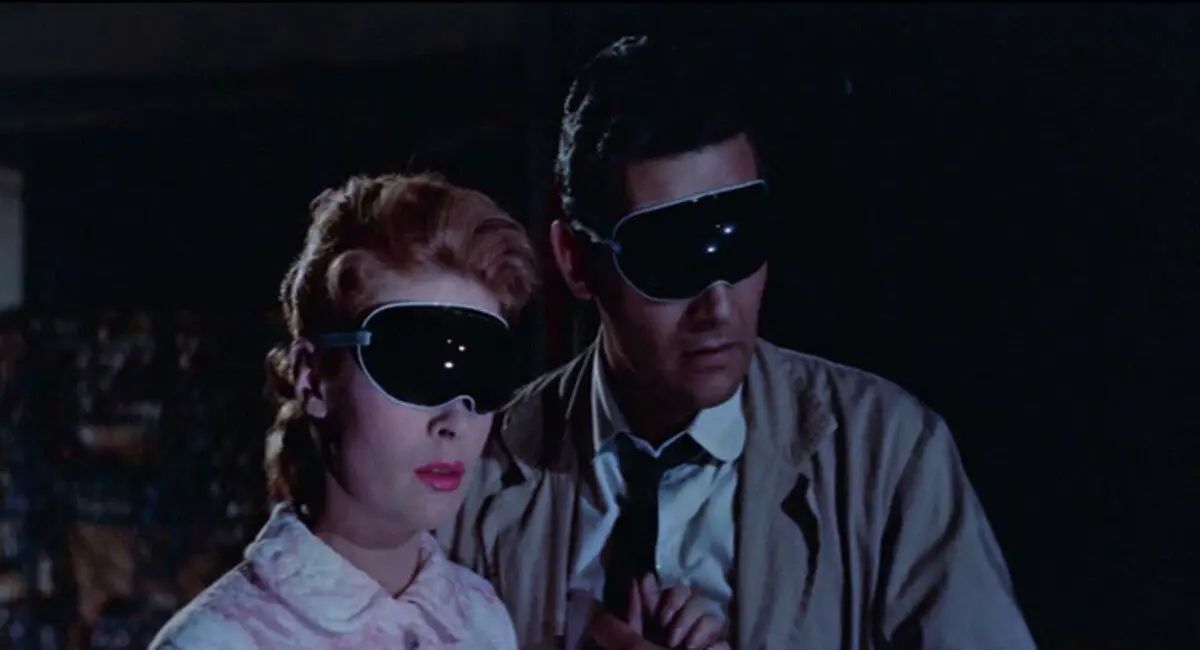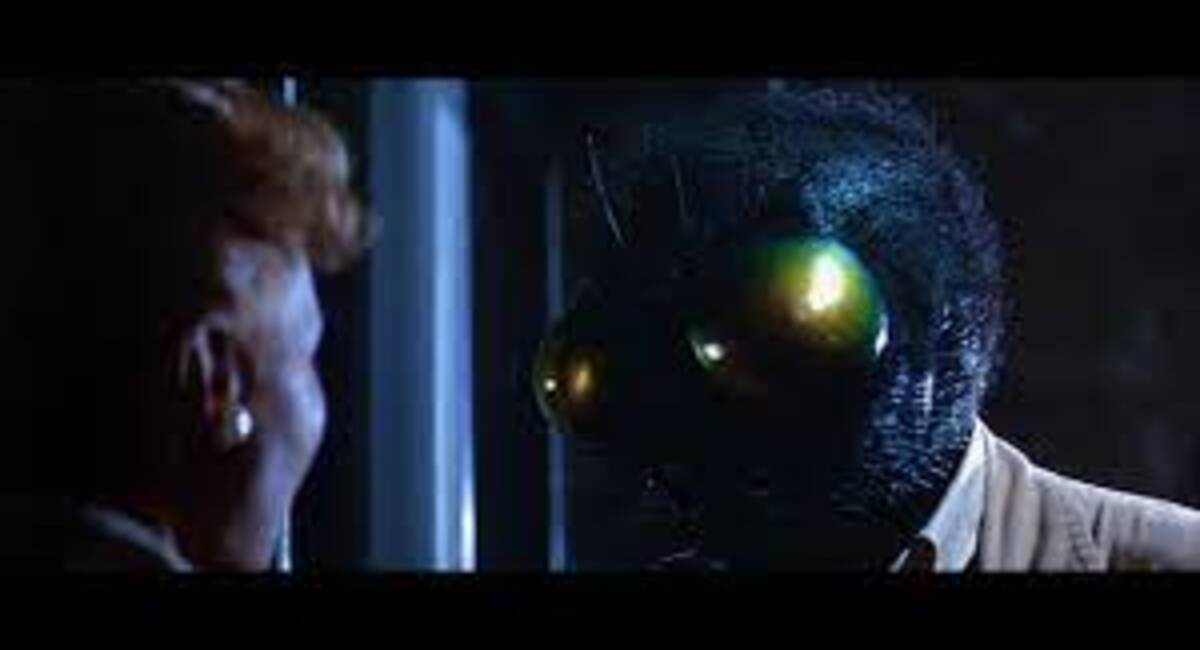Before we get into the nuts and bolts of The Fly (1958), I feel I should be honest with you, dear reader. I hate the remake. Can’t stand it. Think it’s a worthless piece of trash that only exists to shock and revolt its audience. I think it has none of the charm or subtle nuances of the original The Fly (1958) and, if it was down to me, David Cronenberg would’ve been the first director to have a restraining order taken out against him that stated he was not allowed within 100 feet or a camera ever again. Swiftly followed by Rob Zombie.
Now, that might seem like a strange thing to lead with going into this article on The Fly (1958)—especially considering there’s a very good chance I’m going to spend a very large chunk ripping on the movie—but I feel it needed to be said so that if anyone had come to this piece expecting a side by side comparison or me even mentioning the other version, I could save them four minutes of life by letting them know that that won’t be happening here.
You’re welcome.
No, instead of Cronenberg trying his damndest to make me sick or Jeff Goldblum…er, Goldblumming his way through an hour and a half, plus change, today I’ll be focusing on The Fly (1958), where the most revolting thing you had to worry about was David Hedison in a latex mask, drinking rum-laced milk.

Warning: Spoilers Ahead
The Fly (1958) starts with the night watchman of a local factory doing his round. As he’s about to lock up he hears one of the machines start and goes to investigate. When he does he sees Hélène Delambre (Patricia Owens) running from the scene. On closer inspection, he discovers that she has used the metal press to squish her husband’s head into Fois Gras. This bit always makes me chuckle. Not because a man has just had his brain mushed out—what’s wrong with you, you psycho?—but because the colour of the blood that has pooled around what’s left of André Delambre’s (David Hedison) nogging—which as you can imagine, is bugger all—is so violently bright that it reminds me I need to get around to changing the walls in my kitchen.
It’s a trick that a lot of horror movies used during the burgeoning days of Technicolor. The more vibrant and offensive you could make any spilled claret, the more it would repulse those in attendance. Who in turn would run off and tell their friends about it, making their friends suddenly want to go and see The Fly (1958) a lot more than they had when they’d woken up that morning. It’s an obvious move now, but during a time when William Castle was allowed to legally shock patrons of his cinema during screenings of The Tingler, it was a lot cheaper than having to wire up the seats to the mains.
Cut to André’s brother, François Delambre (Vincent Price), sitting in a very fetching smoking jacket at his desk. His phone rings and on picking it up he is informed by Hélène that she needs help as she just made André’s grey matter splurge out all over the place, to which he reacts by laughing and saying that it’s late and he doesn’t have time for jokes. Because, yeah, I’ve spent many a night calling up my friends and relatives, informing them I’ve just murdered my missus. Eventually, she convinces him that she isn’t joking and he calls the Five-O. Or The Gendarmeries. The Canadian Mounties?
The reason I seem confused here is that The Fly (1958) is quite confusing to follow. Not the plot, that’s pretty simple as we shall see, but the location and time that it’s set in are so ambiguous that you have to pay close attention to figure out that we’re actually in the 1960s Canada and not 19th century France. The homes of the Delambre family scream Victorian era and it isn’t until André says later on about the invention of TV that it dawns on you that The Fly (1958) is set in modern times, which explains the car you saw François arrive in that you just didn’t register at the time. Also, it’s not until right at the film’s climax, when the men in white coats come to haul Hélène off to a nice padded room where she can wibble to her heart’s content, do you find out that The Fly (1958) is set in Canada as the relevant ambulance has Montreal written down the side of it. Why this is all left open-ended is never explained and I’ve never been able to track down the reasons behind it, so if anyone reading this knows, hit me up in the comments as it’s driven me nuts for long enough now, that I’d like some sodding closure.
After they have been to the factory that the Delambre brothers own—well, owned in one case I suppose—they head off to confront Hélène as to why she would pop André’s head like a zit. François doesn’t believe that she did it, partly because he’s in love with her but mainly because she doesn’t know how to operate the machinery, only for both he and Inspector Charas (Herbert Marshall) to be informed in minute detail by Hélène as to just how she operated the head squisher. Straight out the gate, Hélène isn’t denying anything. She admits she’s killed her husband, but refuses to reveal why. Then she starts going a tad crazy—or at least acts as if she is—while François and Inspector Charas labour around, trying to figure out just why she bumped him off.
There’s a great scene here that I am very fond of, again for comedy value more than anything even though I doubt very much that that is the way it was meant to be played or came across back in the day. Hélène is confined to her room with a nurse/policewoman tending to her. Curious as to how everything is going, she asks her companion who informs her that they never tell her anything. Hélène then says that they think she’s mad, but she’s not, only to act like a total basket case about two minutes later when nursey tries to swat the bejesus out of a passing fly. As I said, I know it wasn’t meant to be funny, but the timing of the line “I’m not mad” then swiftly followed by her screaming and ranting like a rabid monkey is just comedic gold.
With Hélène doing her best Captain Cuckoo Banana Brains impression—even going so fat as to act as if she has no idea who her own son, Philippe (Charles Herbert), is—it is only when François tells her that he’s captured the fly that she has been so desperately seeking that she agrees to come clean about the whole sordid situation, and after a groovy (baby) special effect leads to a flashback, that’s what we proceed to hear.
If you’ve seen either The Fly (1958) or the remake some nearly 30 years later, you’ll know how this goes. A good man with good intentions tries to create a matter transporter to help benefit the human race. After a series of trials and errors, he achieves just that, yet when he tries to send himself point to point an errant fly enters the machine with him and their DNA becomes spliced. In Cronenberg’s version, this sees Goldblum fall apart, quite literally, while in the original The Fly (1958), producer/director Kurt Neumann decided the best way to get the desired effect of a fly/man hybrid was to do this (pictured below):

The sight of David Hedison in a latex/rubber mask might be about as scary as your kid putting a sheet over their head, jumping out at you, and yelling “Boo!,” but come on. Look at him! He’s a giant fly/man! The work here by Ben Nye is superb—as is the effect when you see Hélène screaming reaction through André’s many, many fly eyes—and I swear that after she faints that they switch masks as in the next scene the creature looks saddened by the fact he’s scared his wife into unconsciousness. I’ve never been able to confirm if that was the case or not but watching it again last night ahead of writing this, I’m sure his eyes are pointed down, as are his pincers, giving him an incredibly melancholy look. On a f*cking fly. I’ll take that over Goldblum pulling bits off himself any day of the week.
There’s also some brilliant dialogue here as well, at least while André can still speak with his own mouth and not just say “buzz, buzz.” For example, before he blasts his own atoms across space and time, he tries it with a dish that comes out the other side fine, but the writing “Made in Japan” is backwards. After fiddling about with the machine some more he sends a newspaper that makes the journey intact, and with the print the right way rounds, so he decides to fire the family pet from box to box. Where the newspaper was a roaring success, this…not so much as the cat never reappears. When he finally irons out the kinks, he comes clean to Hélène by explaining what happened to the puss-puss and that he was still floating around them as cat atoms. I have no idea why I find the idea of a cat pinging around as particles amusing, though it probably has something to do with when it initially goes poof and you can still hear it meowing at the top of its voice. I know, I know. I’m a sick puppy, and I’m going to Hell, but damn, that sh*t is just funny.
Eventually, tragedy takes over as André and the unwelcome insect become one, and even though they try to capture the creature so they can bamf them both back through the matter transporter, every attempt they make fails. This means that for a chunk of The Fly (1958) we are just watching three people attempting to catch an insect, which in hindsight sounds as boring as watching paint dry, but it’s still entertaining as you want them to succeed, even though you know they won’t. In the end, they decide that André and his work must be destroyed so it cannot be used for evil. Though who’d want to raise an army of flies in an attempt to conquer the world is beyond me, as all you’d need to defeat the bastards would be a ton of fly paper and the biggest cans of Raid you could find.
With André now kersplatted in a metal press and Hélène claiming she didn’t kill her husband at all, what she’d killed was a monster, Inspector Charas informs François they’re going to have to arrest her for murder, but she should escape the death penalty as she’s a f*cking mental. Distraught at this news, and knowing that the only way to prove his sister-in-law’s innocence is to find the fly with the human head, François strikes it lucky when Phillipe does just that. Leading Inspector Charas to a spider’s web in the back garden they, and we, watch in horror as a giant plastic…er…I mean, real and not at all fake arachnid chows down on the helpless André as he cries out,
Help me! Help me!

The Fly (1958) is a classic horror movie that you should own if you consider yourself a fan of classic horror movies. As I’ve stated—and as I say a lot about these kinds of films—it’s not scary in any way, shape, or form, but that’s not why you watch something like The Fly (1958). You watch it because of what it was and what it still stands for today. It is a tale of man meddling in things man has no right to meddle in and what the consequences of those actions can be, in this case pretty sodding severe as André first gets turned into a fly/man, and then has to get his wife to turn him into crunchy toothpaste.
It also divided opinion on its release with Ivan Butler calling The Fly (1958)
…the most ludicrous, and certainly one of the most revolting science-horror films ever perpetrated.
While the LA Times said it was
…frightening, which is naturally its primary purpose. It is also more skillful in concept and execution than the average science-fiction effort.
The fact is that if you love creature features then you’re going to love The Fly (1958), even with all its aged cheese on show. Tasty, tasty cheese that needs to be washed down with some rum-laced milk…Mmmmm…buzz…buzz…



